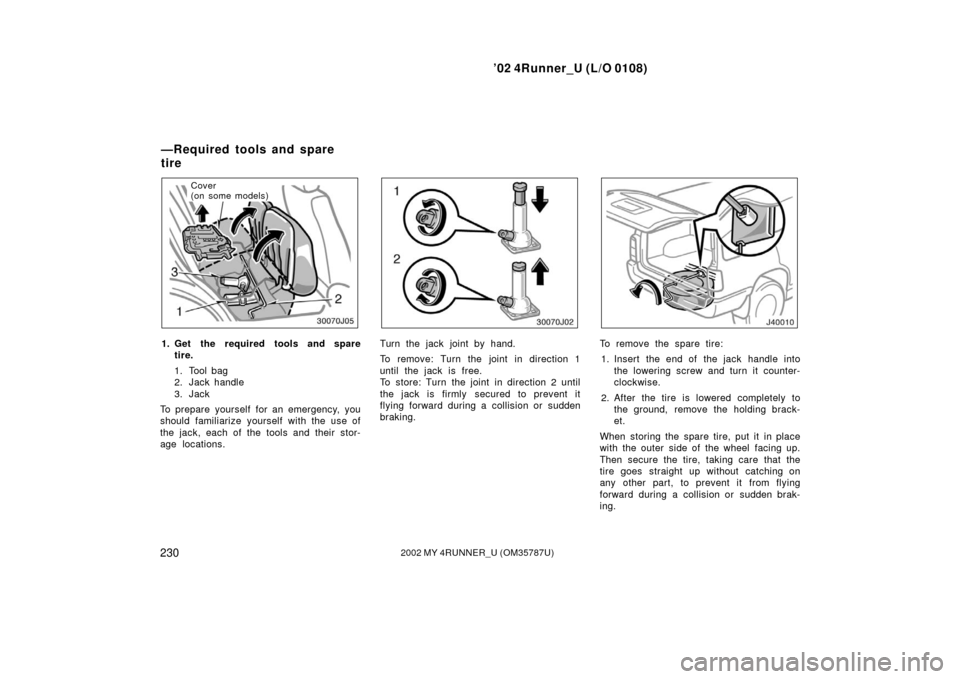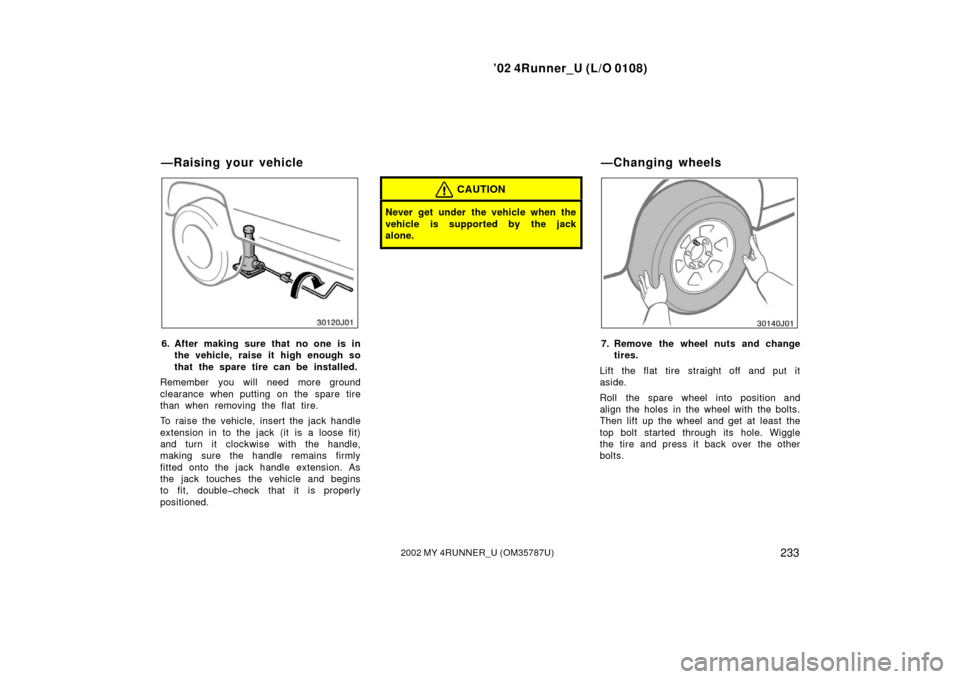Page 236 of 308

’02 4Runner_U (L/O 0108)
2302002 MY 4RUNNER_U (OM 35787U)
Cover
(on some models)
1. Get the required tools and spare
tire.
1. Tool bag
2. Jack handle
3. Jack
To prepare yourself for an emergency, you
should fam iliarize yourself with the use of
the jack, each of the tools and their stor-
age locations.Turn the jack joint by hand.
To remove: Turn the joint in direction 1
until the jack is free.
To store: Turn the joint in direction 2 until
the jack is firmly secured to prevent it
flying forward during a collision or s udden
braking.To remove the spare tire:
1. Insert the end of the jack handle into the lowering screw and turn it counter-
clockwise.
2. After the tire is lowered completely to the ground, remove the holding brack-
et.
When storing the spare tire, put it in place
with the outer side of the wheel facing up.
Then secure the tire, taking care that the
tire goes straight up without catching on
any other part, to prevent it from flying
forward during a collision or s udden brak-
ing.
— R eq u ired to o ls an d sp are
tire
Page 239 of 308

’02 4Runner_U (L/O 0108)
2332002 MY 4RUNNER_U (OM 35787U)
6. After making sure that no one is in
the vehicle, raise it high enough so
that the spare tire can be installed.
Remember you will need more ground
clearance when putting on the spare tire
than when removing the flat tire.
To raise the vehicle, insert the jack handle
extension in to the jack (it is a loose fit)
and turn it clockwise with the handle,
making sure the handle remains firmly
fitted onto the jack handle extension. As
the jack touches the vehicle and begins
to fit, double�check that it is properly
positioned.
CAUTION
Never get under the vehicle when the
vehicle is supported by the jack
alone.
7. Remove the wheel nuts and change tires.
Lift the flat tire straight off and put it
aside.
Roll the spare wheel into position and
align the holes in the wheel with the bolts.
Then lift up the wheel and get at least the
top bolt started through its hole. Wiggle
the tire and press it back over the other
bolts.
—Raising your vehicle —Changing wheels
Page 276 of 308

’02 4Runner_U (L/O 0108)
2702002 MY 4RUNNER_U (OM 35787U)
Check the tires regularly for damage
such as cuts, splits and cracks. If any
damage is found, consult with a techni-
cian and have the tire repaired or re-
placed.
Even if the damage does not appear seri-
ous, a qualified technician should examine
the damage. Objects which have pene-
trated the tire may have caused internal
damage.
Any tires which are over 6 years old
must be checked by a qualified techni-
cian even if damage is not obvious.
Tires deteriorate with age even if they
have never or seldom been used.
This also applies to the spare tire and
tires stored for future use.
REPLACING YOUR TIRES
When replacing a tire, use only the
same size and construction as original-
ly installed and with the same or great-
er load capacity.
Using any other size or type of tire may
seriously affect handling, ride, speedome-
ter/odometer calibration, ground clearance,
and clearance between the body and tires
or snow chains.CAUTION
�Do not mix radial, bias belted, or
bias�ply tires on your vehicle. It
can cause dangerous handling char-
acteristics, resulting in loss of con-
trol.
�Do not use tires or wheels other
than the manufacture’s recom-
mended size.
�Do not use tires of different brands,
sizes and constructions. This may
damage the drive system and pre-
vent the vehicle skid control system
from functioning correctly.
Toyota recommends all four tires, or at
least both front or rear tires be re-
placed as a set.
See “If you have a flat tire” in Section 4
for tire change procedure.
When a tire is replaced, the wheel
should always be balanced.
An unbalanced wheel may affect vehicle
handling and tire life. Wheels can get out
of balance with regular use and should
therefore be balanced occasionally. When replacing a tubeless tire, the air
valve should also be replaced with a
new one.